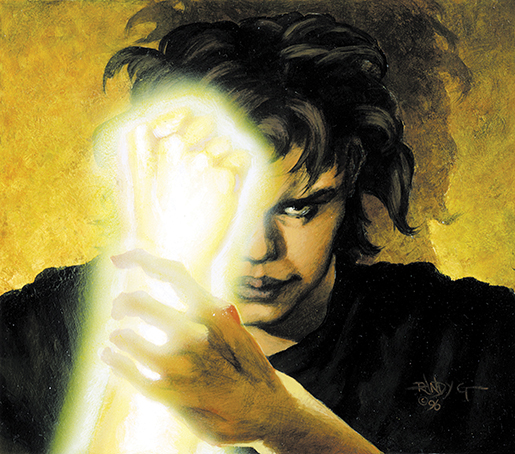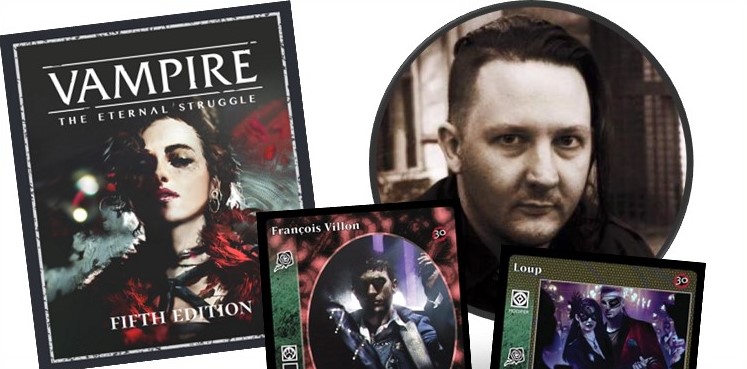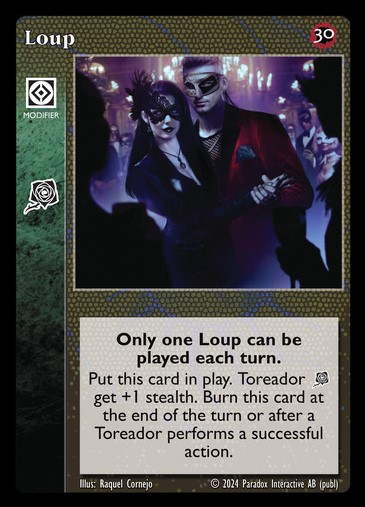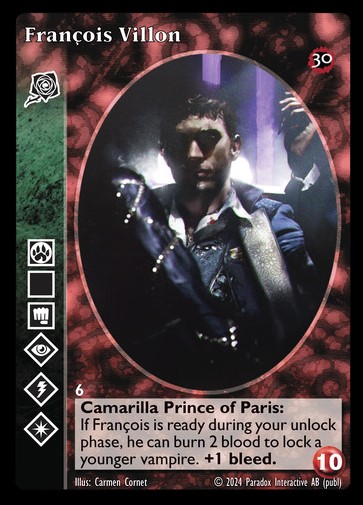
We love our artists and love to spotlight them. Above you can see new fantastic art by Randy Gallegos for the 30th Anniversary version of the classic Vampire: The Eternal Struggle card Third Tradition: Progeny. Randy has been illustrating for the game since the very beginning, back in 1994, so we felt it was a must to ask him if he would like to return and contribute for the 30 year celebration. He said yes, and he also agreed to a interview:
Hello Randy, thanks for taking your time to talk to us. How are you today?
I am a bit stressed as I am leaving today for an event in Washington state for the weekend. However I hit some hard deadlines I had to meet before leaving, so that’s good. I had to clear the schedule so my wife and I could take a vacation for our 26th anniversary straight after the event – illustration deadlines don’t really move for those kinds of things, so you have to work around them!
Tell us a bit about your background as an artist? Are you educated or self-taught?
I studied at the California College of Arts and Crafts in Oakland 1991–1994. I was a Drawing major. With regards to painting however I had to teach myself that since the painting department there was full of abstract and other gallery artists who couldn’t draw or paint very well.
You have been illustrating for games a long time now. What kind of assignments do you prefer these days?
In recent years, owing to a series of traditional landscapes I’ve worked on, I’ve been commissioned a good number of fantasy landscapes as assignments. That’s fine, but I prefer figurative, contemplative or moody/surreal types of work. But I like imaginative art generally, so it’s pretty much all fine. I tend to shy away from aggro violence, dark/occultic imagery or highly sexualized themes, though.
What artistic techniques do you prefer? It seems your style has changed since the 1990s.
Most of my work is still painted traditionally, although in recent years there have been times I’ve worked entirely digitally or a mix, depending on a client’s requirements or deadline since digital is much faster than paint. While I began my career as an acrylic painter, in the late 90s I transitioned to oils. Most of my painted work starts in acrylic and then is completed in oil.
For my Vampire: The Eternal Struggle 30th Anniversary illustrations, I painted the figure for “Business Pressure”, in acrylic, then scanned it and put it into the digital composition and finished it there.
For “Third Tradition: Progeny” I rendered it out in pencil and acrylic, scanned that and then overpainted it digitally.
When I was just starting out, working on Vampire: The Eternal Struggle as my first project at the age of 19, and for the first few years of my career, there was a wide disparity in the quality of my work – there were stretches where I produced illustrations from thumbnail to finish every two workdays. That was bad practice, but also fees were much lower then for the many card games back in the 90s, so that was certainly one strategy to earn a living back then. So sit was evident which pieces caught my interest particularly, as I tended to slow down for them.
Over time I took the hit of scheduling less work and focusing more on quality, and hoping it would eventually get me out of the pit that that practice was digging for me as well as the financial hit that stopping that practice meant for a few years while I got back to creating the kind of work I wanted to do when I was in art school – back then paintings were typically larger, more highly referenced and with more time spent. There were professional pieces in that early era that embodied the kind of artist I knew I was and could be, and I knew I was short-changing myself by not giving every piece that kind of effort.

How do you work with models and photos?
When appropriate and schedule/fee allows, I’ll use models. If there’s a good amount of time and I know a friend I can rope in, I’ll do that. If time/fee allows and I need a look outside of what I can get from my immediate circle, I’ll hire a model. Particularly within my circle, often I’ll use a model for the general body type and pose/lighting, while changing the look/features.
We guess many who read this have seen your art for Vampire: The Eternal Struggle. What else have you worked with?
Certainly my 30-year association with Magic: The Gathering is my best-known and largest body of work. While I tended to devote more time to early Magic work than other projects – and this showed – I also had to redouble my efforts to stay relevant there, among a growing and quickly improving stable of fellow artists who moved the quality in that game forward aggressively. So in terms of what I am most proud of, it has been making the changes and improvements necessary to stay relevant to that game over the entirety of my career.
Outside of Magic, I’ve worked with a slew of games that have come and gone, some children’s book stuff, YA covers and the like. Outside of illustration, my series “Hearts for Hardware” is an ongoing series of traditional still life paintings dedicated to the history of video game hardware. Of my personal work, it’s the work that I am most excited about.


What other work do you have upcoming?
The vast majority of my illustration is in Magic: The Gathering these days, so that’s the main place you’ll find me. It’s unusual now for me to take on work with other clients, but the 30th anniversary of Vampire: The Eternal Struggle was special to me as it was the game I started this career on and Black Chantry was great to work with. I also have some art in Brotherwise Games’ upcoming The Stormlight Archive RPG series of books which will Kickstart this summer.
Big thanks to Randy Gallegos for this chat, and thanks for your lovely art!
RELATED:
– Vampire: The Eternal Struggle turns 30 – welcome to the ball!
– Vampire: The Eternal Struggle celebrates 30 years with a very special set!
Copyright © 2024 Paradox Interactive AB. www.paradoxinteractive.com. All rights reserved. Vampire: The Eternal Struggle and Vampire: The Masquerade® are trademarks and/or registered trademarks of Paradox Interactive AB. All rights reserved.
















